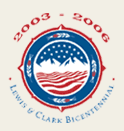| |||||||||||||||||||||||||||||||||||||||||||||||||
|
|
American Indian NationsMany Nations, Many Voices From the perspective of American Indians, Lewis and Clark were not discoverers and describers of an unknown land, but rather sightseeing foreign visitors whose experiences depended on the good will and assistance of the local residents. --------------------------------------------------------------- "The great chief of the Seventeen great nations of America, impelled by his parental regard for his newly adopted children on the troubled waters, has sent us to clear the road, remove every obstruction, and make it the road of peace between himself and his red children residing there." ---Meriwether Lewis, 1804 ---------------------------------------------------------------- Two hundred years ago, the Corps of Discovery recorded information about more than 100 different tribal nations west of the Mississippi . Lewis and Clark documented their encounters and described the assistance that tribes provided. The Corps of Discovery survived because of the generosity and hospitality of our ancestors. Today, we are the physical manifestation of the dreams and prayers of our ancestors. Their stories serve as a reminder and a challenge to protect and restore natural and cultural resources. This is a mutual heritage, for we all share this landscape. But not every tribe is the same. We have different languages, different songs and different customs. Taking Care of the Gifts Native lives and cultures are richly diverse, yet we are all inextricably connected to the land, water and sky, and our ancestral union with them. The Creator bestowed these gifts upon us, and we have the responsibility to ensure that the land, forests and ranges, the lakes, rivers and streams, the wildlife habitats and wetlands are protected and free of pollution. We come from these lands and we will always be here. ------------------------------------------------------------------ "Our elders knew the curves of the hillsides and the lines of the trails as intimately as they knew the curves and lines of their mothers' faces." ---Germaine White, Salish-Kootenai ------------------------------------------------------------------- Since 1778, over 2.2 billion acres of tribal lands have been ceded to the U.S. government. Today, 56 million acres remain in Native hands. We share this landscape with many other beings. With our neighbors-cities, counties, state and federal agencies, and other tribal nations-we face mutual concerns and problems, and must find mutual solutions. All lands are precious. Our children and seven generations to come will inherit healthy ecosystems and abundant natural resources if we make intelligent decisions today. Visit the Circle of Conservation Advisors page. Languages of the Earth Our Native languages directly reflect the intimate knowledge of the ecosystems that have sustained us for thousands of years. Throughout the 19th and early 20th centuries, the U.S. Government forcefully promoted policies to eradicate Native languages and cultural practices in efforts to "civilize" and assimilate tribal people. In the few generations since, tribes nationwide have struggled to keep ancient languages alive. Of the 300 original Native languages in North America , only 175 exist today. Of the 175, 55 are spoken by one to six elders and only 20 are spoken by all age groups in everyday use. Language preservation and revitalization efforts are urgent races against time, and some tribes have language instruction and revitalization programs underway. To learn more: www.ipola.org. www.pieganinstitute.org. For millennia, tribal nations have lived and prospered along what is now the Lewis and Clark National Historic Trail. So there are thousands of tribal cultural resource areas, burial grounds and sacred sites along the trail. These sacred places are connections to our history, messages from our ancestors, treasures for our future and the cradle of our existence. The flesh, blood and bones of our ancestors are holy. Our archaeological sites, sacred sites and objects, and burial sites are monuments, and like monuments of other great nations, they deserve respect. Desecration and looting of tribal cultural resources is a growing national disgrace and an irreparable loss to all Americans. Tribes along the Lewis and Clark Trail are concerned about the potential for more destruction due to increased visitation during the Lewis & Clark Bicentennial. On your bicentennial journey, help protect these sacred treasures by:
Valuable laws have been passed that help us protect our rich heritage, such as the Native American Graves Protection and Repatriation Act (NAGPRA, 1990), the American Indian Religious Freedom Act (AIRFA, 1978), and Executive Order 13007 (19960 on sacred site protection) -------------------------------------------------------------------- "Sometimes in the evening I sit, looking out on the big Missouri . The sun sets, and dusk steals over the wate r. In the shadows I seem again to see our Indian village, with smoke curling upward from the earth lodges, and in the river's roar I hear the yells of warriors, and the laughter of little children as of old. It is but an old woman's dream..." ----Waheenee, Hidatsa -------------------------------------------------------------------- Download a guide to Indian Country This brochure contains information about American Indian events, institutions, sites and perspectives. Click here to download. -------------------------------------------------------------------- The Many Nations, Many Voices Exhibit conveys the mission of the Circle of Tribal Advisors: to commemorate and acclaim the contributions and goodwill of our ancestors and to plan for the well being of future generations.--------------------------------------------------------------- Circle of Tribal Advisors Tribal Nations Whose Homelands Lewis and Clark Explored A place to find tribal happenings in your area. Tribal Museums & Cultural Centers Tribal Involvement Grants Who Was Sacagawea
|

|
|||||||||||||||||||||||||||||||||||||||||||||||
| login | tell a friend about this site | contact us | © 2003 | Turn Flash ON | |||||||||||||||||||||||||||||||||||||||||||||||||

